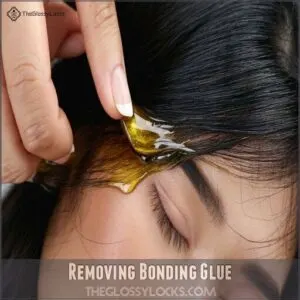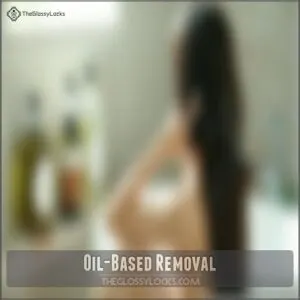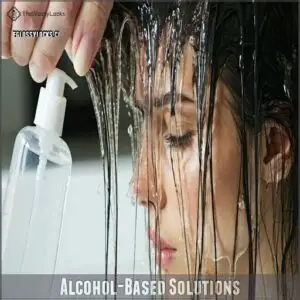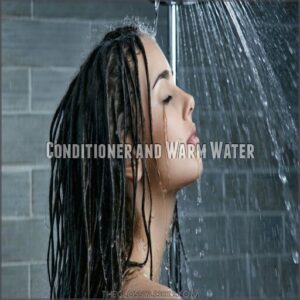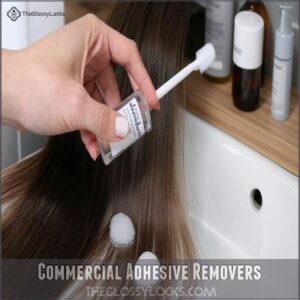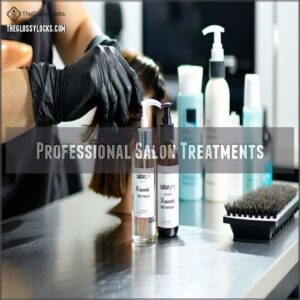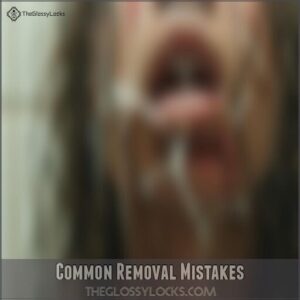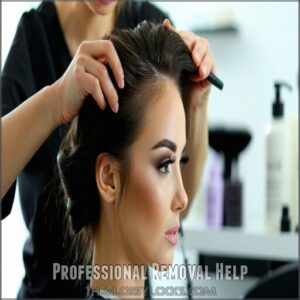This site is supported by our readers. We may earn a commission, at no cost to you, if you purchase through links.

Start by soaking your hair in oil—coconut, olive, or baby oil works well.
Massage it in, let it sit for 15-30 minutes, and gently comb out the loosened glue.
If oil doesn’t cut it, try conditioner with warm water or an alcohol-based adhesive remover designed for hair.
Avoid harsh chemicals or forceful pulling, as both can damage your strands.
Stuck glue? Consider a professional stylist to prevent breakage.
Once the glue is gone, focus on hydrating your hair to restore its health.
Small steps make a big difference!
Table Of Contents
- Key Takeaways
- Removing Bonding Glue
- Get Bonding Glue Out
- Safe Removal Methods
- Effective Glue Removal
- Aftercare and Maintenance
- Common Removal Mistakes
- Professional Removal Help
- Frequently Asked Questions (FAQs)
- What dissolves hair bonding glue?
- How do you remove bonding glue from your hairline?
- How to remove ghost bond glue from hair system?
- How to remove Salon Pro hair bonding glue?
- Can bonding glue cause scalp infections or damage?
- Is bonding glue removal different for sensitive scalps?
- Does glue removal affect colored or dyed hair?
- How to prevent bonding glue from hardening quickly?
- Are there specific oils for different glue types?
- Conclusion
Key Takeaways
- Use oil-based solutions like coconut or olive oil to soften the glue, then gently comb it out after letting the oil sit for 20-30 minutes.
- Try alcohol-based removers for tougher adhesives, but always condition your hair afterward to minimize dryness.
- Avoid harsh chemicals like acetone or nail polish removers as they can damage your hair and scalp.
- After removing the glue, focus on hydrating your hair with deep conditioning treatments to restore moisture and strength.
Removing Bonding Glue
You’ll need to break down the bonding glue’s adhesive properties before attempting to remove it from your hair.
Breaking down adhesive properties is key—soften bonding glue first for safe, damage-free hair removal and healthier strands afterward.
Using oil-based products or specialized removers will soften the glue, making it easier to comb out without causing damage to your strands.
Assessing Glue Type
Before attempting removal, you’ll need to identify what type of bonding glue you’re dealing with.
Different adhesives have varying Glue Composition and Adhesive Strength, which affects how you’ll remove them.
Check the product packaging if available, or assess the texture and resistance when gently tugging.
Latex Sensitivity is important to note, as some removers might trigger reactions.
Understanding your specific hair adhesive’s properties makes it possible that you’ll choose the right hair glue solvent for effective removal.
Preparing Hair and Scalp
Now that you’ve identified your glue type, proper preparation makes removal much easier.
Before tackling bonding glue, you’ll need to set up your hair and scalp for success.
- Start with a thorough scalp assessment to identify all glued areas
- Apply oil pre-treatment to soften the adhesive bonds
- Perform patch testing with your chosen removal product
- Use gentle detangling to separate hair strands without breakage.
By following these steps, you can ensure a smoother removal process, and remember to always prioritize gentle detangling to protect your hair.
Choosing Removal Method
Several factors should guide your choice of glue removal method.
Consider your hair’s sensitivity, the specific glue type used, and product availability in your home.
Your budget concerns and time commitment also matter.
Oil-based solutions work well for most adhesives, while alcohol-based products dissolve hair glue faster but may cause dryness.
Choose the safest hair adhesive removal technique that balances effectiveness with gentle care for your specific situation.
Get Bonding Glue Out
Now that you’ve identified the bonding glue in your hair, it’s time to tackle removal.
Getting glue out of hair doesn’t have to be a nightmare when you use the right techniques. Your hair type matters – fine hair requires gentler approaches than coarser textures.
Product buildup around the glue can make removal trickier, so timing is everything. You’ll want to dissolve hair glue when it’s most vulnerable – usually after applying your chosen removal agent and giving it time to work.
Don’t rush the process; patience prevents breakage. Remember that hair adhesive removal works best when you match the solution to the specific bonding agent used.
Glue residue can damage your scalp health if left too long, so don’t postpone removal. When done properly, you can remove bonding glue without sacrificing your strands, and this is achieved by using the right techniques and understanding that hair type matters.
Safe Removal Methods
You’ll find several gentle yet effective methods to remove bonding glue without damaging your precious strands.
These techniques use common household items that break down adhesives while protecting your hair’s integrity.
Oil-Based Removal
Oil-based removal offers a gentle solution for stubborn bonding glue.
Apply coconut oil, olive oil, or almond oil directly to the affected areas. Heat the oil slightly for better penetration, then massage it into your scalp where the glue sits.
Let it work for 20-30 minutes before combing through with a wide-tooth comb. This method breaks down adhesive while nourishing your hair, unlike harsher alternatives.
Many people tout coconut oil’s benefits for hair health, and this method is a great example of using natural ingredients to achieve the desired result.
Alcohol-Based Solutions
While oils work well for many glue types, alcohol-based solutions offer a powerful alternative for stubborn bonding agents.
Alcohol works by breaking down the adhesive chemicals in hair glue quickly and effectively.
For best results when using alcohol-based solutions:
- Apply D-Bond Gel directly to glued areas for gentle, effective dissolution
- Spray Wicked Roots Break Up around tape extensions for zero-residue removal
- Use 70% isopropyl alcohol instead of 99% to minimize hair drying
- Let the alcohol sit for 5 minutes before combing through with a fine-toothed comb
- Follow with conditioner to counteract alcohol’s drying effects
For targeted application, consider using D-Bond Gel products.
Conditioner and Warm Water
For out of your hair troubles, conditioner and warm water create a powerful combination against bonding glue.
Apply a generous amount of deep conditioner directly onto glued areas. Let it sit for 15-20 minutes while warm water helps soften the adhesive.
Gently work through tangles with a wide-tooth comb. Rinse thoroughly to prevent residue.
This method minimizes hair damage while effectively removing glue and using warm water helps to soften the adhesive, making the process more manageable.
Effective Glue Removal
You’ll find several proven methods to effectively remove bonding glue from your hair without causing damage or breakage.
Whether you prefer commercial removers, professional treatments, or simple home remedies, the right technique can dissolve stubborn adhesive while protecting your strands, using methods that are proven to be effective.
Commercial Adhesive Removers
Commercial products offer a lifeline when stubborn bonding adhesive refuses to budge. Professional remover ingredients typically contain gentle solvents that break down hair glue effectively.
- Apply Maxi Professional Maximum Hair Glue Remover with a Q-tip directly to bonds
- Work remover into glued areas using a small brush
- Wait until you feel the bond loosening
- Continue application until hair separates completely
- Finish with a gentle cleansing shampoo
If the adhesive contains dye, consider using a product with ammonia and bleach-free formulas to ensure safe and effective removal of hair glue. This approach helps in maintaining the health and integrity of the hair, making it a crucial step in the hair separation process, especially when dealing with professional remover ingredients.
Professional Salon Treatments
While commercial products offer DIY solutions, salon professionals have specialized tools and expertise for stubborn glue situations.
Your stylist or hair extension technician can assess damage while using professional-grade removers like Salon Pro 30 Seconds Hair Bond Remover.
They’ll apply products precisely with Q-Tips and follow with conditioning treatments.
Salon removal costs typically include a thorough glue residue removal shampoo treatment, leaving your hair soft and manageable without risking further damage, using techniques that ensure a gentle and professional-grade approach.
Home Remedies and Techniques
You’ll find powerful solutions for bonding glue right in your kitchen.
Try an oil soak with olive or coconut oil—warm it slightly, apply generously, and let sit for 20 minutes.
Natural solvents like dish soap work well for stubborn spots. Gentle combing with a fine-tooth comb removes softened adhesive without damage.
For thick bonding adhesive, Vaseline application can break down the glue safely without harsh chemicals.
Specialized products like hair glue removers can also provide effective solutions for bonding glue, using natural solvents is a good alternative.
Aftercare and Maintenance
You’ll need to restore moisture and strength to your hair after removing bonding glue to prevent breakage and promote healing.
Hydrating shampoos, deep conditioning treatments, and avoiding heat styling for several days will help your hair recover from the stress of adhesive removal, which is crucial for preventing breakage.
Washing and Conditioning Post-Removal
Now that you’ve successfully removed that stubborn bonding glue, your hair needs some TLC. Start with gentle cleansing using a sulfate-free shampoo to wash away any residual oils or solvents.
Follow with a repairing conditioner to begin hydration restoration. Apply a deep conditioning hair mask for 15-30 minutes to replenish moisture.
Consider incorporating sulfate-free shampoos into your routine for maintaining hair’s pH balance. Your scalp health depends on proper aftercare—don’t skip this essential step in your recovery process.
Preventing Future Glue Mishaps
Everyone wants to avoid sticky situations with hair glue. Proper application is your first defense against future removal headaches.
- Always perform patch testing before applying new adhesives to prevent allergic reactions
- Consider professional install services for proper glue application
- Explore adhesive alternatives like tape-ins or clip-ins for easier management
- Learn gentle removal techniques before your next installation to prevent future removal headaches.
Common Removal Mistakes
You’ll save yourself time, frustration, and possibly some hair if you avoid these common mistakes when removing bonding glue.
Making these errors can lead to damaged strands, scalp irritation, and stubborn residue that becomes even harder to remove, leading to more frustration.
Avoiding Harsh Chemicals
Your beauty routine shouldn’t come at the cost of your hair’s health. When removing bonding adhesive, avoid harsh chemicals like acetone and nail polish removers that can damage both hair and scalp.
Instead, opt for natural alternatives like baby oil or commercial products specifically designed for hair glue removal. DIY removers using natural oils won’t trigger chemical reactions or scalp sensitivity while effectively dissolving the glue.
Many conventional shampoos contain harmful shampoo ingredients that can cause similar damage.
Preventing Hair Breakage
While harsh chemicals can be effective, they often lead to another problem: hair breakage.
To protect your strands during glue removal, always work with damp hair and use gentle detangling techniques.
Apply oils for hydration before attempting removal, maintain protein balance with conditioning treatments, and avoid overprocessing.
Never pull or yank at stubborn adhesive. Instead, take your time and use protective styling afterward to help your hair recover.
Minimizing Skin Irritation
Skin irritation from hair glue removal can be a hassle, but it’s avoidable with care.
Always start with a patch test before trying products, and stick to soothing options.
- Use oil-based removers for gentle application instead of alcohol if your skin is sensitive.
- Hydrate after removal with calming ingredients.
- Avoid harsh bonding adhesive removers, prioritizing safe glue removal techniques.
Professional Removal Help
If you’re struggling to remove bonding glue at home, a professional stylist can be your best solution.
They’ve the right tools and expertise to safely remove stubborn glue while protecting your hair from damage.
Salon Assistance for Stubborn Glue
For stubborn hair glue, professional glue removal is your best bet.
Salon assistance guarantees safe removal, minimizing damage to your hair.
Experts use bonding adhesive removers specifically designed for hair extension removal.
Addressing glue mishaps may require a salon visit for hair color correction.
Here’s a quick snapshot:
| Expertise | Safe Methods | Aftercare Options | Cost Considerations |
|---|---|---|---|
| Certified Stylists | Gentle Techniques | Hydrating Treatments | Varies by Service |
| Glue Precision | Advanced Tools | Repairing Masks | Affordable Rates |
| Minimal Damage | Custom Solutions | Moisture Restoration | Worth the Value |
| Skilled Handling | Efficient Results | Personalized Advice | Transparent Pricing |
Post-Removal Hair Care and Advice
After salon assistance, focus on moisturizing and strengthening strands to repair damaged hair.
Use hydration treatments and a deep conditioner to restore scalp health.
Protective styling reduces stress on hair while preventing breakage.
For future prevention, follow hair care tips like avoiding harsh adhesives and ensuring proper removal, which helps in maintaining healthy and resilient hair post-removal, and Consistent care helps you maintain healthy, resilient hair post-removal.
Frequently Asked Questions (FAQs)
What dissolves hair bonding glue?
Oil, rubbing alcohol, or acetone can dissolve bonding glue effectively.
Massage an oil like olive or baby oil onto the area, let it sit, then gently comb.
For tough glue, try alcohol or acetone cautiously.
How do you remove bonding glue from your hairline?
Gently apply oil, like olive or baby oil, to the hairline and let it sit for 20 minutes.
Massage the area, then use a fine-toothed comb to carefully loosen and remove the glue.
How to remove ghost bond glue from hair system?
To remove Ghost Bond glue from a hair system, apply 99% isopropyl alcohol or a professional adhesive remover.
Let it sit for 5-10 minutes, then gently wipe or comb away the loosened glue.
How to remove Salon Pro hair bonding glue?
To remove Salon Pro hair bonding glue, apply oil like olive or coconut to the glued area, let it sit for 20-30 minutes, gently massage and comb through.
Wash thoroughly with shampoo and conditioner.
Can bonding glue cause scalp infections or damage?
Bonding glue can be a sneaky culprit, potentially causing scalp irritation or even infections if left too long.
It clogs pores, traps dirt, and stresses your hair.
Proper removal and scalp care are essential!
Is bonding glue removal different for sensitive scalps?
If you’ve got a sensitive scalp, prioritize gentle methods like natural oils or baby oil.
Avoid harsh chemicals, rubbing alcohol, or acetone.
Always test products first and take your time to prevent irritation.
Does glue removal affect colored or dyed hair?
Removing glue can strip moisture, which may fade or dull dyed hair.
Use oil-based removers, avoid harsh chemicals, and deep condition afterward to protect color vibrancy and maintain your hair’s health.
Be gentle!
How to prevent bonding glue from hardening quickly?
Apply the glue in thin, even layers, ensuring the room isn’t too cold or dry.
Store the glue in a cool, airtight container when not in use to maintain consistency and prevent drying out.
Are there specific oils for different glue types?
Different oils work best for specific glue types.
Olive oil or almond oil handles bonding glue well, while citrus oils tackle tape adhesives effectively.
Coconut oil is versatile but works better for lighter adhesive bonds.
Conclusion
Tackling how to get bonding glue out of hair might seem overwhelming at first, but with the right approach, it’s manageable.
Whether you choose oil, conditioner, or alcohol-based removers, focus on being gentle to protect your strands.
Avoid harsh chemicals or tugging, as these can cause damage. If stubborn glue remains, don’t hesitate to seek professional help.
Once your hair is glue-free, nourish it with proper aftercare. Restoring your hair’s health is the final, vital step.

